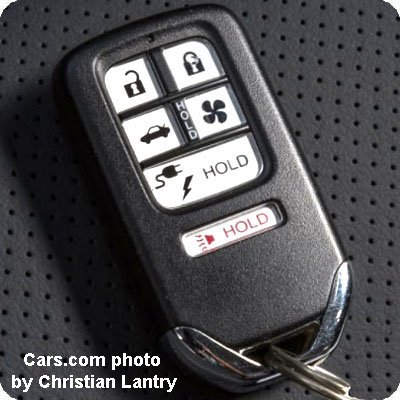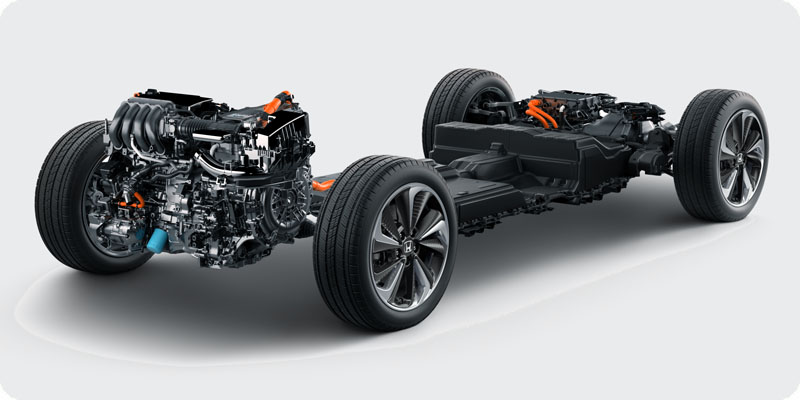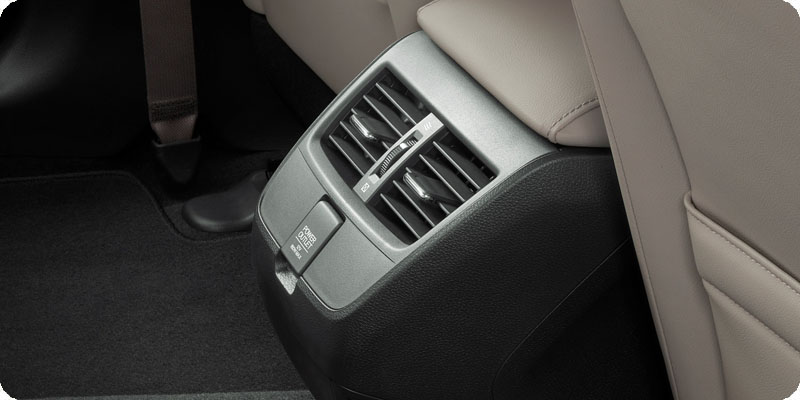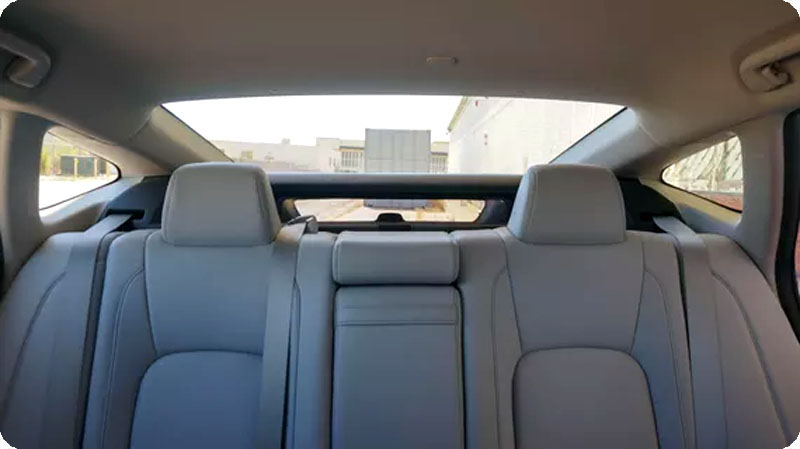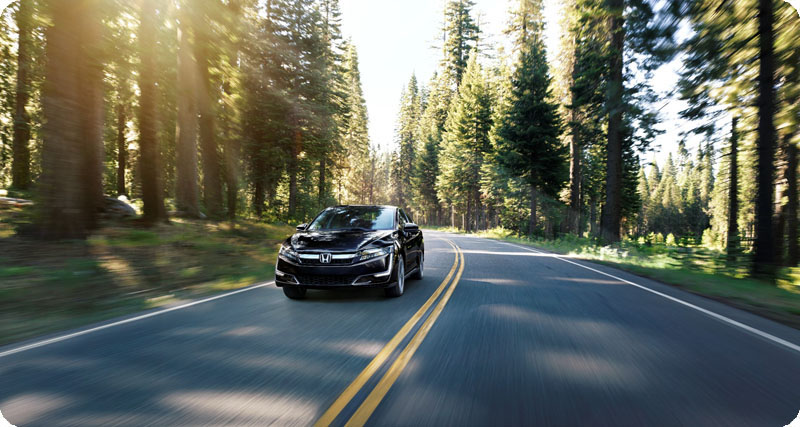
Clarity by Night
2018 Honda Clarity Plug-In Hybrid
Facts, Speculations, and Opinions
Updated January 1, 2017
11/16/17—Clarity Press Release: A flood of information!
12/01/17—Clarity website goes live: The floodgates burst open!!
12/12/17—Clarity Press Kit: An inundation of info!!!
1/1/18—Honda airs the first Clarity ad on the Rose Bowl broadcast
Clarity Plug-In Hybrid Leads The 2018 Rose Bowl Parade

Parade Grand Marshal Gary Sinise arrives in style
Highlights of Hondaís November 16th Press Release for the Clarity Plug-In Hybrid:
The good news is that the $7,500 federal electric vehicle tax credit can bring the price of the Touring model below $30,000. What at first appeared to be bad news—the elimination of the EV tax credit by the House's version of the tax-reform bill—has turned into good news because it appears the elimination was eliminated when the House and Senate got together to define the final tax-reform bill. Perhaps the automotive lobby persuaded the legislators not to eliminate the EV tax credit—I would be surprised if the letter to that effect, signed by 22 US mayors, was noticed in Washington.
Notable information from the December 1st website unveiling:
11/16/17—KBB.comís "Electric/Hybrid Car Best Buy of 2018"
Kelly Blue Book®, has named the Clarity Plug-In Hybrid the "Electric/Hybrid Car Best Buy of 2018." The KBB.com article includes a video review (from which I extracted the image of a silver Clarity Plug-In Hybrid appearing below).
Introduction
The Clarity Plug-In Hybrid is the first widely available Honda since the Insight that represents a significant step forward in automobile technology (thereís an opinion right off the bat). The intention of this web page is to pull together some background information with the known facts about the Honda Clarity Plug-In Hybrid. Iím also offering my speculations and opinions.
Hondaís 11/17/17 press release answered the most important questions I was asking, but you will find many remaining questions (framed in square brackets) sprinkled throughout the text below.
—John E Johnson, aka Insightman
(contact: john at this website)

2018 Honda Clarity Plug-In Hybrid
(Click on image to go to Hondaís Clarity Plug-In Hybrid Site)
Fuel-Cells First
Honda, the worldís largest manufacturer of internal combustion engines (ICE), looked to the future. The company realized the non-renewable resources required to power internal combustion engines and the climate-change effects caused by those engines would eventually make them obsolete. Honda, like many other companies, saw clearly that the future of mobility was electric. The company has announced its intention for electrified vehicles to comprise two-thirds of its global automobile sales by 2030.
There have been electric cars since the early days of the 20th century. The two main disadvantages that all electric cars suffer when compared to ICE-powered cars are limited range and lengthy recharge time. It used to be said that the range of an electric car is about the same as the range of an ICE-powered car with a red warning light glowing on its gas gauge.
Tesla attempted to address these problems by packing their cars with very large battery packs and then building special high-voltage/high-amperage "Supercharger" recharging stations. Still, the maximum range of the $94,000 2017 Tesla Model S is a scant 335 miles and it takes more than 9 hours on a Level 2 (240-Volt) home charger to achieve that range. Visiting a Tesla Supercharger recharging station can reduce this time to less than 2 hours, provided there are no other Teslas already occupying the chargers at that station.

2004 Honda FCX Hydrogen Fuel-Cell Experimental Vehicle
Honda decided to employ hydrogen fuel-cell technology to solve both the range and recharging problems of battery electric vehicles. The first viable hydrogen fuel-cell vehicle in the U.S., the 2004 Honda FCX V4 (the 4th version of the 1999 original), was produced in extremely small numbers and leased to a few government agencies in California. According to Wikipedia, it was the first fuel-cell vehicle to receive U.S. government certification for commercial use.
Hondaís 2017 Clarity Fuel-Cell car offers range: it can travel 366 miles between hydrogen fill-ups. And, unlike the lengthy recharge time for a battery electric vehicle, refueling the Clarity Fuel-Cell car with hydrogen takes only a few minutes. Of course, a big asterisk cannot be overlooked: there are only a handful of hydrogen filling stations in the world.

2008 FCX Clarity Fuel-Cell Car
In 2008, Honda began leasing the first hydrogen fuel-cell vehicle available to real people, the FCX Clarity. It was rumored to cost more than $1M to manufacture, so it was not produced in significant numbers. But a very small number of people near Hondaís US headquarters in Torrance, California, were finally driving fuel-cell vehicles. Hydrogen filling stations were almost nonexistent, so Honda helped sponsor a few of them in the southern California area. The data Honda gained from the customers who leased this car helped them design the next-generation Clarity Fuel-Cell car.
Gas, Gasoline, and Electricity

2013 Honda FCEV Concept Car
At the 2013 Los Angeles Auto Show, Honda unveiled this wonderful fuel-cell-powered Honda FCEV concept car. If you look closely, you can see a couple of styling elements that actually made it from this concept to the production Clarity. I personally hoped for ALL the styling elements to carry through to the production model, but this almost never happens. I was spoiled when the 1999 Honda Hybrid VV concept car became my 2000 Insight with virtually no changes.
Also in 2013, Honda brought to a limited market the Fit EV, a battery-electric vehicle (BEV) that offered a range of 82 miles. Available only on lease for $389/month (then $259/month in 2014), it was tagged by the press with the "compliance car" moniker, which implied Honda was making this car only to comply with the California Air Resources Board (CARB) requirements for manufacturers to sell a certain number of zero-emission cars or be prohibited from any selling any cars in California. The additional weight of the batteries made the Fit EV less fun to drive and its limited 89-mile range was eclipsed by competing BEVs. Honda discontinued the manufacture of the Fit EV, but still leases them as pre-owned vehicles.
For the 2014 model year, Honda released a plug-in version of the Accord Hybrid that could achieve an all-electric range of 13 miles. To test its viability, Honda made the Accord Plug-In Hybrid available in only a few markets in the United States. Unfortunately, potential customers did not believe the value provided by 13 miles of gas-free driving justified the carís $10,000 premium over the $30,000 cost of an Accord Hybrid. Honda discontinued its first plug-in hybrid trial after just a year.

2015 Honda FCV Concept
Honda brought its FCV Concept car to Detroitís North American International Auto Show in 2015. The FCV Concept demonstrates many of the styling elements that carried through to the production Clarity. Note the angled part of the rear fender partially covering the top of the tire, the aerodynamic deflection vent in front of the rear wheel, and the cues to the Clarity's front fascia.
Also note the design of the wheels on the right side of the FCV Concept. They are mirror images of the wheels on the left side. To simplify the stocking of wheels in the Honda parts bin, the production Clarity Plug-In Hybrid wheels will use the same (left-side) wheels all around. Speaking of wheels, you might have already guessed that the production carís batteries and gas tank don't leave any room in the trunk for a spare. Even a "space-saving" spare for a car with 18-inch wheels would take up quite a lot of space.
Late in 2016, Honda began leasing the ready-for-prime-time 2017 Honda Clarity Fuel-Cell car. Although the Clarity is almost exactly the size of the Accord, it does not share the Accordís platform. The need to incorporate a large hydrogen tank behind the rear seats and a smaller hydrogen tank under the rear seats required Honda to develop an entirely new platform for the Clarity Fuel-Cell car. At present, the Clarity Fuel-Cell car is available only in California. Although it is a lease-only ($2,499 down and $369/month) proposition, Honda has said that the sticker in the window would read $59,365 if the company was to make the Clarity Fuel Cell car available for sale.
In the summer of 2017, Honda began leasing the Clarity Electric ($1,999 down and $269/month). The big number on the sticker would reportedly be $37,495, if Honda sold the Clarity Electric. Other than some external trim differences, the Clarity Electric looks just like the Clarity Fuel-Cell car.
Some automotive pundits have decried the Clarity Electricís "paltry" 89-mile range, calling it a limited-range compliance car. However, there are no other comparably appointed electric vehicles at the Clarity Electricís price point. A Chevy Bolt can go 238 miles per charge, but itís a modestly appointed sub-compact car. The larger Tesla Model S can go further, but it costs 2 or 3 times as much as the Clarity Electric and its interior is decidedly more Spartan. At present, the Clarity Electric is available only in California and Oregon.

Honda decided to make a third version of the Clarity, the Clarity Plug-In Hybrid, instead of resurrecting the Accord Plug-In Hybrid (it was likely infeasible to fit a 17 kWh battery into the 2018 Accord Hybrid). Unlike the its Clarity siblings, the Clarity Plug-In Hybrid includes an internal combustion engine (ICE). Honda originally sold the Clarity Plug-In Hybrid in all 50 states and Canada, but in 2019, the company changed its mind and decided to make the car a special-order item in states other than California. It remains for sale in limited numbers in Canada.

Engineers hide the Clarityís batteries under the front and rear seats
In September, 2017, Honda revealed the Clarity Plug-In Hybrid will have an all-electric range of 47 miles, only 6 miles less than that of the smaller Chevy Volt (which Chevrolet has discontinued). On a 240-Volt J1772 Level 2 EVSE (Electric Vehicle Service Equipment), the Clarity Plug-In Hybrid's 6 kW on-board charger requires as only 2.5 hours for a full recharge (in nice weather, our Clarity takes just over 2 hours for a full recharge). Honda recommends a 32-Amp EVSE to achieve this short recharging period. Recharging a completely discharged battery using the Level 1 (120 Volt) EVSE included with the car takes about 12 hours. Unlike the Clarity Electric, the Clarity Plug-In Hybrid cannot use a Level 3 DC Fast Charger.
The 2018 Clarity Plug-In Hybrid has two paddles on the rear of the steering wheel to control the amount of braking-regen. Although these paddles provide 4 increasingly aggressive braking-regen settings, the highest setting is not aggressive enough to allow "one-foot driving." With one-foot driving (which is possible with the Chevy Bolt and Nissan Leaf electric cars), the driver rarely needs to use the brake pedal. By simply lifting off the accelerator pedal, the driver can quickly slow the car to a complete stop while maximizing the regeneration of electric power. However, it seems paradoxical that this feature for reclaiming braking energy by recharging the battery on-the-go cancels itself when the car is accelerated or comes to a complete stop in Econ mode. Recharging the battery would seem to be a natural activity when driving in Econ mode.

The Clarity Plug-In Hybridís engine is a 1.5-liter 4-cylinder "hyper-efficient" Atkinson-cycle gasoline-powered mill, which is based on the 1.5-liter DOHC i-VTEC engine first used in the 2015 Honda Fit, according to Hondaís Natalie Kumaratne, Environment & Safety Public Relations. So the valves are driven by a long-lived timing chain instead of a worrisome timing belt. The naturally aspirated (ie. no turbocharger) Clarity engine can deliver up to 102 horsepower and 99 lb.-ft. of torque. Car and Driver provides a good explanation of the Atkinson combustion cycle and its benefits.
The air-conditioner compressor and the water pump are both electric, making this a "belt-less" engine. You can lean in under the hood without worrying about your tie getting wrapped up.

i-MMD drive-motor/generator, starter-motor/generator, clutch, and assorted gears
The Clarity Plug-In Hybrid employs the two-motor Intelligent Multi Mode Drive (i-MMD)
hybrid system Honda introduced with the 2014 Accord Hybrids. When powered by the battery only, the
Clarity Plug-In Hybridís i-MMD electric drive motor can supply up to 121 hp. After the starter motor/generator
starts the ICE and then switches to generator mode, the drive motor can supply up to 181 hp and 232 lb.-ft.
of torque. Again,
Car
and Driver has the best explanation of Hondaís novel way of combining the output from an internal
combustion engine with power from an electric motor.
[Question: Does the drive motor still deliver 232 lb.-ft. of torque when operating only on battery power?]
Hondaís method for combining the output of an engine and a motor simultaneously offers benefits over a less-sophisticated plug-in hybrid that runs exclusively on battery power until the battery is discharged and then switches to its ICE to provide additional range (a "range-extender," as it were). The combined-power approach enables engineers to better optimize the sizes of both propulsive units. To provide the same acceleration as the Clarity Plug-In Hybrid, a hybrid that can use only one propulsive unit at a time would need both a larger electric motor and a larger ICE.
Hereís what normally happens as the Honda Clarity Plug-In Hybrid driverís right ankle is flexed:
The above sequence of events applies to Econ mode only. The limited operation of the accelerator-pedal detent is described in more detail in the discussion of modes below.
Modes vs. Modes

The Clarity Plug-In Hybrid provides three user mode buttons on the console:
Two additional user modes don't get their own buttons:
However, under the hood the car's i-MMD hybrid system actually operates on its own set
of three basic drive modes. In a paper titled "Development of Sport Hybrid i-MMD Control System for 2014
Model Year Accord," authors Hirohito Ide, Yoshihiro Sunaga, and Naritomo Higuchi describes the three
i-MMD drive modes:
The i-MMD system uses computer algorithms and its three basic drive modes to implement the five user-selectable modes. In fact, four of the 5 user-selectable modes incorporate all three of the i-MMD drive modes. The exception, HV CHARGE Mode, uses only HV drive mode.
Although I might wish for one, there is no button to lock the Clarity Plug-In Hybrid into EV drive mode. If there was such a button the driver would not have instant access to maximum engine-assisted acceleration in a moment of desperation. Of course, EV driving is the main attraction for a plug-in hybrid car, so the Clarity Plug-In Hybrid provides tactile and visual feedback to help the driver maintain EV drive mode. When traveling in EV drive mode, pressing hard on the accelerator switches to HV drive mode for maximum acceleration.
ECON Mode is the option for people who want to maximize the efficiency of the Clarity Plug-In Hybrid. In ECON mode the car remains in EV mode until the accelerator pedal is nearly to the floor. At this point, the driver feels a tactile increased resistance in the pedal. Pressing through the click switches from EV drive mode to HV drive mode. Also, ECON mode reduces the power used by the climate-control system. Once selected, ECON Mode remains in effect until another mode is chosen. If ECON Mode is in effect in cold weather, the driver's heated seat is activated when the car is started so the more current-needy climate-control system can be left turned off. ECON Mode remains in effect when the Clarity Plug-In Hybrid is turned off and on again. A green 4-leaf, one dot plant appears at the top of the instrument panel to indicate ECON Mode is in effect.
SPORT Mode increases the sensitivity of the accelerator pedal. The car won't actually accelerate faster in SPORT Mode than in ECON Mode, but it feels faster because the pedal doesn't have to be depressed very far to summon up strong acceleration. Also, HV drive mode arrives earlier in the accelerator pedal travel—before the click that warns ECON Mode users of the switch. SPORT Mode reverts to NORMAL Mode when the Clarity Plug-In Hybrid is turned off. Unique to SPORT Mode is that the Deceleration Selector Paddle's regen level remains in effect while you're driving until you change or reset it. In other modes, the regen level is reset automatically after a few seconds. Two red LED bars flanking the instrument panel indicate when SPORT Mode is in effect.
NORMAL Mode doesn't get a button. If the Clarity Plug-In Hybrid is in SPORT Mode when it's turned off, it will be in NORMAL Mode when it's next turned on. Also, if the SPORT Mode button is pressed when SPORT Mode is in effect, or the ECON Mode button is pressed when ECON Mode is in effect, the car will switch to NORMAL Mode. NORMAL Mode provides a throttle sensitivity between that of ECON and SPORT Mode. Unlike ECON Mode, NORMAL Mode does not reduce the power to the climate-control system but like ECON Mode it retains the Deceleration Selection Paddle regen level for just a few seconds. There is no indicator for NORMAL Mode.
The HV button sounds like it would lock the car in HV drive mode, but it doesn't. Instead, when the driver presses the HV button (which works along with ECON, NORMAL, and SPORT Modes), the HV Mode "freezes" the battery level (it's "state-of-charge"), using both HV drive mode and EV drive mode. HV Mode makes the Clarity Plug-In Hybrid act like a non plug-in hybrid, so if the driver uses battery power to accelerate or climb a hill, the system will then regenerate enough power to return the battery to the same state-of-charge as when the HV button was pressed. "HV" appears at the top of the instrument panel when HV Mode is in effect.
The HV button can also select HV Charge Mode by holding the button down for a few seconds. HV CHARGE Mode is the only one of the 5 user-selectable modes that uses only one of the 3 basic i-MMD drive modes: HV drive mode. Selecting HV CHARGE Mode uses the engine-powered starter-motor/generator to simultaneously power the drive-motor and recharge the battery pack. Curiously, when the state-of-charge in the battery reaches 57.7%, the Clarity Plug-In Hybrid switches to regular HV Mode, which then maintains the state-of-charge at that level. If you want a full charge, you have to plug-in. HV CHARGE appears at the top of the instrument panel when this mode is in effect.
In addition to the accelerator pedal detent for ECON mode, the Clarity Plug-In Hybrid's Power/Charge Gauge shows the driver when the engine will be engaged in any of the three user-selectable modes.
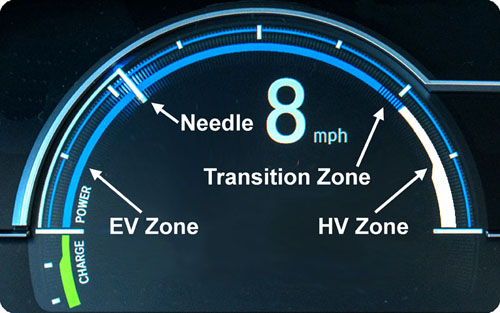
Clarity Plug-In Hybrid Power/Charge Gauge
As the driver presses on the accelerator pedal, the white needle in the Power/Charge Gauge indicates the amount of power going to the wheels. While the needle remains in the blue EV Zone, the engine remains dormant and the battery powers the drive-motor. As the needle moves into the segmented Transition Zone, the starter-motor/generator starts the engine instantly (no chug-chug-chug) and then the engine starts using the starter-motor/generator to create power (what a symbiotic two-way hand-off!). When the needle reaches the white HV zone, the entire curve of the Power/Charge Gauge turns white and remains white while the engine-generated power is supplementing the battery power going to the drive-motor.
The location of the Transition Zone varies according to the selected user mode. The EV Zone is smaller in NORMAL Mode than in ECON Mode, and smaller still in SPORT Mode.
Here's how the three i-MMD modes come into play as the Clarity Plug-In Hybrid accelerates, cruises at low speeds (below 45 mph), cruises at higher speeds, and decelerates. When the engine is stopped, the i-MMD system is in EV Mode. HV mode is when the engine is turning the starter-motor/generator, which joins the battery to power the drive-motor turning the wheels. In Engine drive mode the engine is running (clutched and geared to turn the wheels), the starter-motor/generator is idle, and the drive-motor is generating power to charge the battery.

When the car is cruising, Honda's i-MMD system can intermittently alternate between engine and motor operation to enhance the thermal operation of the engine. When cruising at low speeds, the i-MMD system can alternate between EV and HV modes. When cruising at high speeds, the i-MMD system can alternate between EV and Engine drive modes.
The Clarity Owners Manual discusses EV and HV modes in detail, but Engine drive mode is a
stepchild mostly hidden from view. Clarity drivers love the quiet operation of the i-MMD system in EV mode
and tend to take care to keep the system in that mode. However, if a trip cannot be completed on battery power
alone, the Clarity Plug-In Hybrid can use Engine drive mode to maximize the combined range of this large-ish,
4,000-pound hybrid with a small-ish 7-gallon gas tank. The Clarity informs the driver that Engine drive mode is in effect by displaying a
tiny gear icon in the center of the energy-flow display. There is an audible indication of Engine drive
mode because the speed of the engine becomes proportional to the road speed of the car. In contrast,
when operating in HV mode the engine runs at the speed best suited to efficiently generate power to meet
both the needs of the current driving situation and the needs of the battery. The "overdrive" clutch connects the engine through a set of gears (a 1-speed transmission,
as it were) to drive the wheels. The drive-motor becomes a generator in Engine drive mode so while the engine
is turning the wheels, it's also charging the battery using the larger of the two motor/generators. When the
battery has sufficient charge, the i-MMD system can switch to EV mode. As shown in the above diagram, while
cruising at high speeds the i-MMD system can alternate between Engine drive mode and EV mode. Now Can I Avoid Gas Stations Forever? We've been driving our Clarity Plug-In Hybrid for nearly 6 months and we still have half
of the gas that came with the car still in the tank. However, we have yet to take a trip longer than 60
miles. Honda reports the Clarity Plug-In Hybrid can achieve an EPA mileage rating of 44/40/42
mpg (city/highway/combined) when running only on gasoline. My last-century Honda Insight can easily top
70 mpg (using both ICE and battery power), but this tiny all-aluminum hybrid with its 0.9 kWh battery pack
weighs less than half as much as the mid-sized Clarity Plug-In Hybrid with its hefty 17 kWH battery pack. So
it's not surprising that the larger, heavier car running without battery support would use more gas.
However, we'll see what kind of gas mileage an Insight-trained foot can extract from the Clarity in its
comparable HV (Hybrid Vehicle) mode when warm weather returns. The EPA rates electric car efficiency in Miles-Per-Gallon equivalent (MPGe). The
Clarity Plug-In Hybrid is rated at 110 MPGe when running on battery power. Although my aging Insight achieves spectacular gas mileage, itís a one-trick pony.
A Spartan, 2-seat, one-trick pony. The aim of Clarity Plug-In Hybrid is directed at a much broader target:
to achieve environmental responsibility without compromising on comfort or "driveability." Driveability is not a well-defined concept, but in my experience, Honda understands
it very well. Thatís why Iím such a Honda fan-boy. Speed, handling, ergonomics, visibility, comfort,
and even confidence in a carís reliability and safety all contribute to driveability. Every car design involves compromises to achieve an overall goal. The ability to
travel in the Clarity Plug-In Hybrid on battery power exclusively was in some situations a victim
of the compromises required to maintain driveability. Consider these two requirements: When the driver needs to go faster right now, it shouldnít be necessary to search
for a mode button. Honda engineers came up with the accelerator pedal "click" or "detent" to give the driver
access to maximum power without thinking about how to get it. Thatís driveability. The compromise is that the
driver must exercise some right-ankle restraint in order to travel only on electric power—thereís no
button for that. The delivery of heat in cold weather is particularly important in a battery-powered
car because it affects not only the carís occupants but also the carís batteries. Lithium-ion
batteries donít do well in cold temperatures and Canadian Clarity Plug-In Hybrids actually have
electric battery warmers to protect the batteries (sadly, the big trade-off is that the Canadian Touring
models don't get the electric-motor adjustable seats delivered in US models. The charge-holding capability of lithium-ion batteries is reduced in cold weather
(for example, our Clarity Plug-In Hybrid predicts 37 miles of all-electric range on a full charge when
the temperature dips below 30° Fahrenheit), but the operation of the Canadian-exclusive battery warmers
will reduce the all-electric range even more. If the Clarity activates the warmers during recharging, then
fully recharging the battery may take longer than when the temperature is warmer. Very, very cold temperatures can actually damage lithium-ion batteries, so the Clarity
Plug-In Hybrid is programmed to refuse to start when the temperature is below minus 22° Fahrenheit!
Thatís decidedly not driveability, but those expensive batteries must be protected. Unlike the Clarity Electric and Fuel-Cell cars, the Clarity Plug-In Hybrid has an ICE
to generate heat (hmmm, heat from ICE doesnít sound quite right, does it?). When the temperature dips to
14°F or below, the ICE starts up so it can warm passenger compartment (and the batteries below the
seats and rear floor). To provide cabin heat while travelling on battery power when the ambient temperature is
above 14°F, the Clarity Plug-In Hybrid provides resistive (electric) heating, as do its two ICE-less
siblings. Of course, when you divert battery power to make heat, your all-electric mileage will
vary—and not in a positive way. So the Clarity Plug-In Hybrid can alternatively use hot water from
the ICE to warm the occupants when the ICE is running. The Clarity Plug-In Hybrid's resistive heater
actually heats water that's sent through the same in-cabin heater core that the ICE uses. As noted in the list above, there are other situations when the Clarity
Plug-In Hybrid activates its ICE automatically: At certain higher speeds, the ICE is mechanically connected
to gears that turn the front wheels (see Engine Drive Mode above). Another
instance is when you want to go faster than 100 mph. At that speed, the Clarity Plug-In Hybrid cuts off all
battery support, leaving the ICE all by its lonesome to soldier on in the pursuit of triple-digit speeds.
Please donít expect the ICE to achieve 42 mpg at 100 mph (Note: the Clarity Plug-In Hybrid's top speed is
105 mph). The Clarity may also start the engine as part of a "System Check." The Owners Manual says
this: "While the check is being conducted, the engine may periodically turn on and off. This, however, is normal.
Once the engine starts, it will continue to run until the system reaches operating temperature." Another engine-activation situation: The Owners Manual says "the engine starts
automatically when the engine has not started for a long time." This message appears on the
instrument panel: "Engine Started for Oil Circulation." It makes sense to keep the engine oiled up.
You wouldn't want the expensive 0W20 oil doing nothing in the oil pan while the cylinders go
dry. It will be interesting to learn how the Clarity defines "a long time." Warning: Your Mileage May Vary Of course you've heard that caveat before, but it has a special meaning for
drivers who drive their Clarity Plug-In Hybrid primarily on EV power. The car provides estimates
for the remaining range in EV miles, HV miles, and combined miles. In an attempt to provide the
most accurate estimates possible, the system notes your driving style. Even though the EPA rates
the all-EV range for the Clarity Plug-In Hybrid at 47 miles. If you're skillful and the weather
isn't cold, you can get more than 60 miles on a charge. So you may see a number that high on
the remaining range readout after recharging. The big surprise comes after an EV driver finally has to grudgingly visit
a gas station. The computer looks at the big number of miles the car travelled since the previous
fill-up, calculates a miles-per-gallon number, and then multiplies that result by 7, the number
of gallons the tank holds. That calculation can result in some ridiculously high estimates for
HV remaining miles. Many owners see more than 1,000 miles supposedly available even though the
EPA numbers indicate a maximum combined range of 340 miles! So those are my speculations and some actual explanations about the priorities and
that Hondaís engineers set regarding all-electric operation. The Clarity Plug-In Hybrid wonít let you
completely eliminate time-consuming trips to the gas station, but it can make those bothersome visits
much less frequent. Different Modes for Different Driving Styles As previously discussed, the Honda Clarity Plug-In Hybrid can use both gas and battery
power at the same time. However, the car offers mode selections that allow the driver to prioritize one or
the other. The Honda Clarity Plug-In Hybrid offers 3 modes that vary when the ICE kicks in to
generate more electricity for acceleration. The three modes are Normal, Sport, and Econ. The Econ mode
resists calling upon the ICE while the Sport mode is grateful for the assistance. Normal mode? Who
would ever choose Normal? It doesnít even get its own button! Thereís also a Hybrid Vehicle (HV) mode, which works in conjunction with the three
previously mentioned modes. HV mode lets you use the ICE to conserve the charge in the battery pack for
later use. For example, you could use HV mode to get from the country to the city, where youíd switch
off HV mode and have many miles of non-polluting all-electric range remaining. The Owners Manual describes a variation of the HV mode: HV Charge mode. If you hold
down the HV button, the "HV CHARGE" indicator lights up on the instrument panel. This mode enables you
to dedicate more of the engineís power towards recharging the battery—recommended to be used only
while driving at high speeds. It is not recommended for use in stop-and-go city driving. After about an
hour of high-speed driving, the HV Charge mode will charge the battery to about 58% of a full charge,
when the system automatically switches from the charge-increasing HV Charge mode to the charge-conseving
HV mode. So to drive the Clarity Plug-In Hybrid running only on battery power, the driver can
select Econ Mode and then avoid pressing the accelerator beyond the detent. When the battery is nearly
discharged, the Clarity switches to HV mode, preserving a small charge for brief accelerations. To
conserve the charge in the battery by driving primarily on ICE power, the driver can select HV Mode. You may have thought I was being a bit dismissive of the Normal drive mode earlier.
Well, my brief discussion was more detailed than the Normal drive mode information in the Clarity Owners
Manual. It's just a single word in one sentence: On the same page as the brief mention of Normal mode is a graph
that illustrates how the accelerator detent (or "click") operates in each of the three drive modes:
Econ, Normal, and Sport. I wonder where the axis-label names, "EV drive frequency" and "Driving
force" came from? How many meetings were required to decide how to impart the information
in this graph? I admit that terminology is better than anything I could come up with. The top bar, representing Econ mode, shows how the accelerator-pedal click provides a
form of haptic feedback telling the driver when the Clarity is starting the engine to provide additional
acceleration beyond what the battery can provide. The second and third bars, representing Normal and Sport modes,
respectively, illustrate that the accelerator-pedal click provides no useful feedback whatsoever in these
modes, because the engine in these modes starts up long before the driver feels the click. Either Honda
engineers decided the click would be confusing if it was felt at different points in the travel of the
accelerator pedal, or it was too difficult (ie. expensive) to implement a variable-position click. Then there is the matter of the way the deceleration paddles work in Econ mode. In Sport
mode, the braking-regen selections made with the deceleration paddles remain in effect until canceled by
the driver. However, in Econ and Normal modes, the Owners Manual says, "The deceleration paddle selector will
cancel automatically…when you drive with constant speed, situations of acceleration and decelerate just
before stopping your vehicle." So drivers using Sport mode get to feel greater deceleration, as if they were
driving a car with a big, high-compression engine, but Econ-mode drivers using the minus (−) paddle to
maximize the charge in the battery are frustrated by having to remember to hit that paddle 4 times every time
they decelerate. How Far Can This Car Go? Speaking of range (and isnít that all anyone talks about when the subject is electric cars?),
how far can the Clarity Plug-In Hybrid go on a full charge and a full tank of gas? Honda lists the maximum
total range at 340 miles (in Econ mode, I assume). However, the above photo lifted from a
Cars.com review
shows the HV range gauge indicating 343 miles, which is greater than the car's nominal range of 340 miles.
The total available range, the combination of EV and HV miles, is displayed on the instrument panel: What? Only 340 miles?!? The nearly identically sized Accord Hybrid can go 758 miles
on a tankful of gas and it gets only a few more miles per gallon than the Clarity Plug-In Hybrid. The
limit on the total range of the Clarity Plug-In Hybrid is not only the size of its battery, but more
importantly, the size of its gas tank. Of course, as they say, YMMV. I'll be using the hypermiling
skills developed through 18 years of driving my Insight to see how far this car can really go. How big is the Clarity Plug-In Hybrid's gas tank? Subtract the 47 miles of electric
range from 340 miles and divide that 293 miles by 42 mpg and the gas tank capacity comes to roughly
7 gallons! So why does the Clarity Plug-In Hybrid have a motorcycle-sized gas tank? To make room
for the batteries without significantly reducing trunk space (see Clarity Electric) or eliminating
fold-down rear seats (see Clarity Fuel-Cell). The Clarity Plug-In Hybridís trunk measures a sizeable 15.4
cubic feet. Behold the first Honda hybrid sedan to have fold-down rear seats: Look at it this way: While youíre tooling around town on battery power, youíre almost
certain to be carrying the full tank of gasoline from your last visit to the gas station months ago, so
the small gas tank reduces the weight of the gasoline youíre hauling around as you try to maximize your
all-electric mileage. On a long trip, you might choose to reverse the conventional idea of using the ICE as
a "range-extender." Instead, you could start your trip with a fully-charged battery in HV mode to travel
primarily on power from the ICE. Then, if there are no gas stations in sight when youíve reached the
293-mile limit of your 6.9-gallon gas tank, you will still have many miles worth of electric power to find
more of that precious fossil fuel. Which is the Better Hybrid, the Clarity or the Accord? Your choice of a mid-sized hybrid comes down to time versus distance: If you want
to go more than 750 miles between fill-ups, buy an Accord Hybrid. If youíre not a lonnng-distance commuter
and want to potentially go months between bothersome, time-consuming, and potentially dangerous trips to
the gas station, choose the Clarity Plug-In Hybrid. One more thing: Plug-in electricity is cheaper than gas and all of the Accord Hybridís
electricity comes indirectly from gas. Note that some electric power companies offer lower off-hours rates for recharging
electric cars. However, you'll have to install an additional meter and your company may have set limits
on the number of homes that can take advantage of this option. The Large Fuse While reading the Owners Manual I discovered the fuse protecting the Clarity
Plug-In Hybridís main battery is rated at 175 amps! I had to purchase one ($15) just to see what a
175-amp fuse looked like (without having to remove it from our Clarity, of course). Itís appearance
is less impressive than I expected—it isnít a glass tube with a spaghetti-thick piece of
metal inside. However, it is impressive to realize this little fuse can protect a 17-kWh battery.
Looking closely you can see 58V DC in raised lettering. Multiplying 58 Volts times 175 amps comes
out to a whopping 10,150 watts of power flowing through that tiny wire in the center window! Clarity Plug-In Hybrid Features Now that the unique nuts, bolts, and batteries have been covered, itís time to get
to the goodies—the creature comforts and safety features built into the Clarity Plug-In
Hybrid. General Features Safety Features Exterior Features Interior Features Touring-Trim Exclusive Features The 2018 Clarity Plug-In Hybrid, as an evolution of the 2017 Clarity
Fuel-Cell car, does not include some of the latest Honda updates found in the 2018 Honda
Accord. For example, the Clarity does not have the Accordís retro radio control knobs.
Instead of the 2018 Accordís simple blind-spot warning system, the Clarity includes Hondaís older
LaneWatch blind-spot video system from earlier Honda models. LaneWatch provides more information,
but demands more involvement from the driver, who must focus on the dashboard video screen
to evaluate the view from a camera mounted below the right rear-view mirror. Hondaís list of Clarity Plug-In Hybrid features does not include the Clarity
Fuel Cellís Head-Up Display or its Plasmacluster® Ion Technology for improving air
quality. Also, the Clarity Plug-In Hybrid does not offer Hondaís rear Cross Traffic
Monitor, which has been available on other Honda models for years and is now an option with
the 2018 Accord. However, the AAA warns drivers not to trust cross-traffic alert systems,
suggesting itís better to back into a parallel parking place to make it easier and safer to
leave. Clarity Plug-In Hybrid Colors The 6 Clarity Plug-In Hybrid exterior/interior color combinations
are listed below: More Collected Images Thank you for visiting my exhibition of the 2018 Honda Clarity Plug-In Hybrid!

Honda Clarity Plug-In Hybrid, plugged in
[Question: How long is "a long time" for the engine to remain inactive?]

[Question: Why is HV Charge mode limited to recharging to 58% of a full charge?]
There are three drive modes: ECON, NORMAL, and SPORT.
That's it. If you select Econ mode, it remains in effect forever, or until you change it. Otherwise, the
Clarity Plug-In Hybrid starts in Normal mode. The Econ button activates Econ mode, the Sport button
activates Sport mode, and pressing the button for the current mode a second time turns off that mode
and returns to Normal mode.
Accelerator-pedal click operation in different drive modes

The bar-graph in the center represents the state-of-charge of the battery

Honda's nominal 340-mile range may be a conservative estimate

For Comparison Purposes Only

Honda Clarity Plug-In Hybrid trunk
(note trunk see-through window at top)
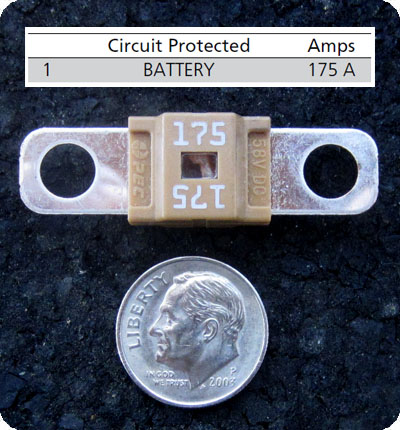
175-Amp Fuse
- Collision Mitigation Braking System™
- Road Departure Mitigation System
- Adaptive Cruise Control with Low-Speed Follow
- Lane Keeping Assist System
[Question: Why do Canadian Claritys have an off-button for this external acoustic alert?]
